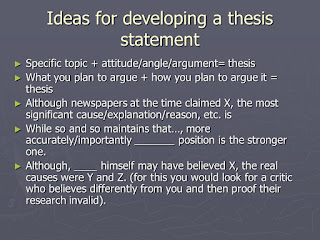So you have read through the assignment and have a general idea of what is expected for this academic essay. Now what? Well, now you have to decide what you are going to write about and how you are going to write about it - this will essentially be your thesis.
- Brainstorm - have a brainstorming session. Grab a piece of paper or open up a new document. Read the assignment sheet once more and simply write down whatever comes to mind. Even if some of your ideas seem silly, write them down anyway. You never know if they could turn into something great.
- Pro/Con List - If you are having trouble deciding between certain topics, make a list of pros and cons for each one. If you have a lot of cons against an idea, it might be a really difficult one to explain/analyze/argue.
- Refer to the text - If your academic essay is related to a text you have read in class, by all means look back at the text or any notes that you have on it. Chances are that you will find something meaningful to write about or that your teacher has hinted at good essay topics beforehand.
Once you have a topic picked out, it is time to craft your thesis. Normally, a thesis will look something like this: F. Scott Fitzgerald’s The Great Gatsby explores the disillusionment of 1920s American society particularly through diction, imagery, and allusions. The thesis takes sentence formatting a step up. We have a subject, verb, and object. The subject is what you are arguing about. It can be a text (in this case, The Great Gatsby) or it can be a person, a character, or even a thing. Next, the verb tells your reader what kind of essay they are about to read. The example above uses the verb “explore,” which tells us that this is an analytical essay. The object, “disillusionment of 1920s society,” demonstrates that there might also be some argument involved on the writer’s part.
Now the thesis goes a step further by adding how you are going to explore the disillusionment of 1920s society in this novel: diction, imagery, and allusions. The detail section is a very important and oftentimes overlooked component of the thesis. Without the “how” details, the reader has no idea how your paper is going to develop. This component adds clarity to your analysis or argument and adds a sense of credibility to your writing. There does not always have to be three details, but the idea is that each detail will be the topic of one or two of your supporting paragraphs in your paper. In general, just make sure that you have enough details to give yourself and your reader a roadmap of where the rest of your paper is going.
Looking back at your thesis is crucial throughout the paper writing process. Very rarely does a thesis stay exactly the same as when you first wrote it. Usually, you will have tweaked or maybe entirely altered parts of it to match your paper as you continue to write. Know that that is normal, healthy even. A thesis that is flexible enough to alter different sections is a strong thesis because it shows that you have a good understanding of the format. The thesis is your guiding tool as you write the paper and in turn the paper will continue to shape the thesis as you develop the different ideas of your topic.
Have you tried the PaperRater automated proofreader yet? What are you waiting for, it's free!





No comments:
Post a Comment
All comments are reviewed by the moderator BEFORE they appear on this page. Spam will be deleted, so don't waste your time or my time.